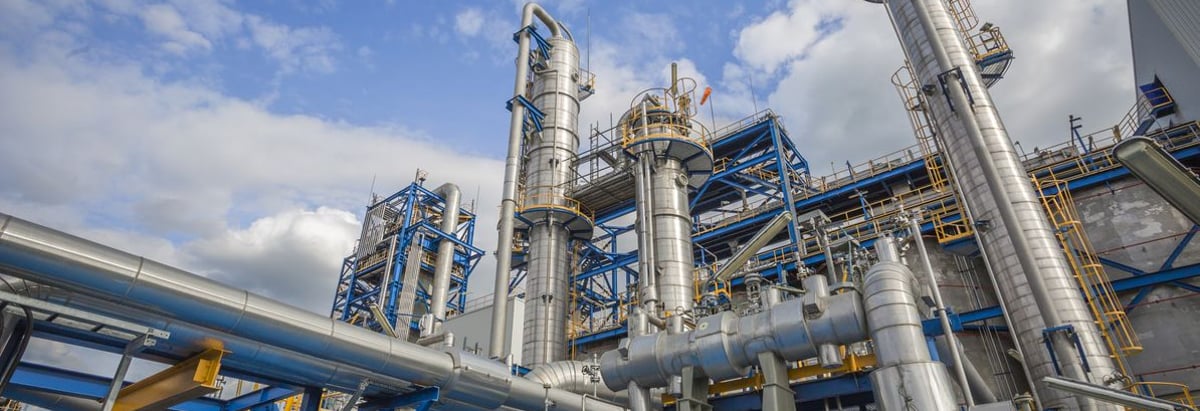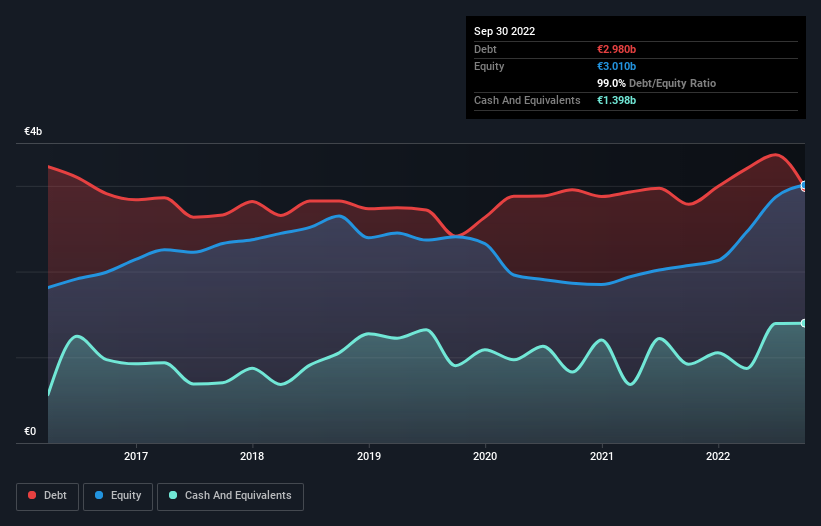- Greece
- /
- Oil and Gas
- /
- ATSE:ELPE
Here's Why HELLENiQ ENERGY Holdings (ATH:ELPE) Has A Meaningful Debt Burden

Warren Buffett famously said, 'Volatility is far from synonymous with risk.' It's only natural to consider a company's balance sheet when you examine how risky it is, since debt is often involved when a business collapses. We can see that HELLENiQ ENERGY Holdings S.A. (ATH:ELPE) does use debt in its business. But the real question is whether this debt is making the company risky.
When Is Debt A Problem?
Debt and other liabilities become risky for a business when it cannot easily fulfill those obligations, either with free cash flow or by raising capital at an attractive price. Ultimately, if the company can't fulfill its legal obligations to repay debt, shareholders could walk away with nothing. However, a more usual (but still expensive) situation is where a company must dilute shareholders at a cheap share price simply to get debt under control. Of course, the upside of debt is that it often represents cheap capital, especially when it replaces dilution in a company with the ability to reinvest at high rates of return. The first step when considering a company's debt levels is to consider its cash and debt together.
See our latest analysis for HELLENiQ ENERGY Holdings
What Is HELLENiQ ENERGY Holdings's Net Debt?
The image below, which you can click on for greater detail, shows that at September 2022 HELLENiQ ENERGY Holdings had debt of €2.98b, up from €2.78b in one year. On the flip side, it has €1.40b in cash leading to net debt of about €1.58b.

A Look At HELLENiQ ENERGY Holdings' Liabilities
We can see from the most recent balance sheet that HELLENiQ ENERGY Holdings had liabilities of €4.20b falling due within a year, and liabilities of €1.80b due beyond that. On the other hand, it had cash of €1.40b and €939.2m worth of receivables due within a year. So it has liabilities totalling €3.67b more than its cash and near-term receivables, combined.
When you consider that this deficiency exceeds the company's €2.48b market capitalization, you might well be inclined to review the balance sheet intently. In the scenario where the company had to clean up its balance sheet quickly, it seems likely shareholders would suffer extensive dilution.
In order to size up a company's debt relative to its earnings, we calculate its net debt divided by its earnings before interest, tax, depreciation, and amortization (EBITDA) and its earnings before interest and tax (EBIT) divided by its interest expense (its interest cover). Thus we consider debt relative to earnings both with and without depreciation and amortization expenses.
HELLENiQ ENERGY Holdings's net debt is only 1.00 times its EBITDA. And its EBIT covers its interest expense a whopping 16.2 times over. So you could argue it is no more threatened by its debt than an elephant is by a mouse. Better yet, HELLENiQ ENERGY Holdings grew its EBIT by 243% last year, which is an impressive improvement. If maintained that growth will make the debt even more manageable in the years ahead. There's no doubt that we learn most about debt from the balance sheet. But ultimately the future profitability of the business will decide if HELLENiQ ENERGY Holdings can strengthen its balance sheet over time. So if you're focused on the future you can check out this free report showing analyst profit forecasts.
Finally, while the tax-man may adore accounting profits, lenders only accept cold hard cash. So the logical step is to look at the proportion of that EBIT that is matched by actual free cash flow. Looking at the most recent two years, HELLENiQ ENERGY Holdings recorded free cash flow of 42% of its EBIT, which is weaker than we'd expect. That weak cash conversion makes it more difficult to handle indebtedness.
Our View
We feel some trepidation about HELLENiQ ENERGY Holdings's difficulty level of total liabilities, but we've got positives to focus on, too. To wit both its interest cover and EBIT growth rate were encouraging signs. Looking at all the angles mentioned above, it does seem to us that HELLENiQ ENERGY Holdings is a somewhat risky investment as a result of its debt. That's not necessarily a bad thing, since leverage can boost returns on equity, but it is something to be aware of. There's no doubt that we learn most about debt from the balance sheet. However, not all investment risk resides within the balance sheet - far from it. We've identified 4 warning signs with HELLENiQ ENERGY Holdings (at least 2 which are concerning) , and understanding them should be part of your investment process.
Of course, if you're the type of investor who prefers buying stocks without the burden of debt, then don't hesitate to discover our exclusive list of net cash growth stocks, today.
If you're looking to trade HELLENiQ ENERGY Holdings, open an account with the lowest-cost platform trusted by professionals, Interactive Brokers.
With clients in over 200 countries and territories, and access to 160 markets, IBKR lets you trade stocks, options, futures, forex, bonds and funds from a single integrated account.
Enjoy no hidden fees, no account minimums, and FX conversion rates as low as 0.03%, far better than what most brokers offer.
Sponsored ContentValuation is complex, but we're here to simplify it.
Discover if HELLENiQ ENERGY Holdings might be undervalued or overvalued with our detailed analysis, featuring fair value estimates, potential risks, dividends, insider trades, and its financial condition.
Access Free AnalysisHave feedback on this article? Concerned about the content? Get in touch with us directly. Alternatively, email editorial-team (at) simplywallst.com.
This article by Simply Wall St is general in nature. We provide commentary based on historical data and analyst forecasts only using an unbiased methodology and our articles are not intended to be financial advice. It does not constitute a recommendation to buy or sell any stock, and does not take account of your objectives, or your financial situation. We aim to bring you long-term focused analysis driven by fundamental data. Note that our analysis may not factor in the latest price-sensitive company announcements or qualitative material. Simply Wall St has no position in any stocks mentioned.
About ATSE:ELPE
HELLENiQ ENERGY Holdings
Operates in the energy sector in Greece, the Southeastern Europe, and the East Mediterranean.
Fair value with moderate growth potential.
Market Insights
Community Narratives




